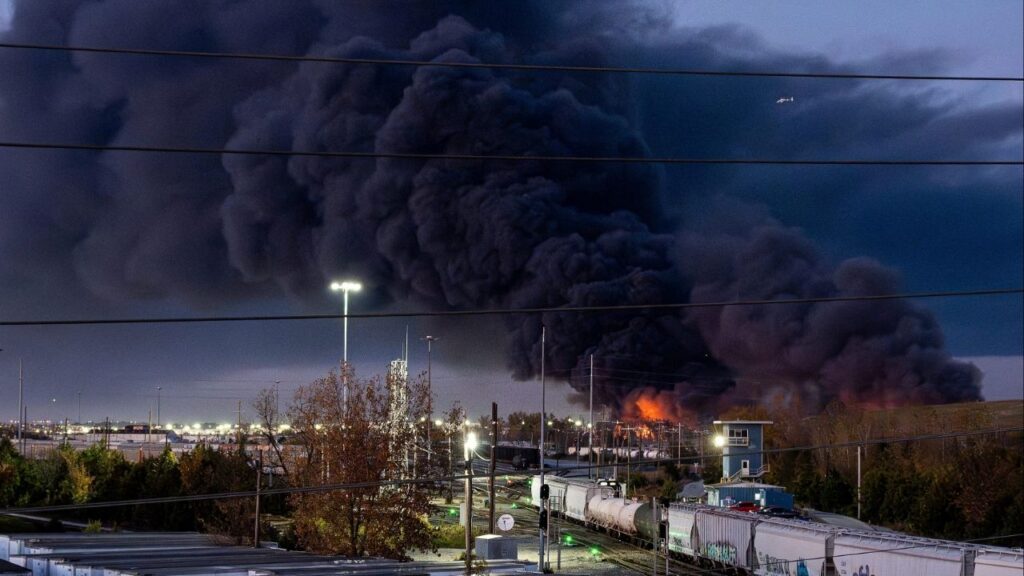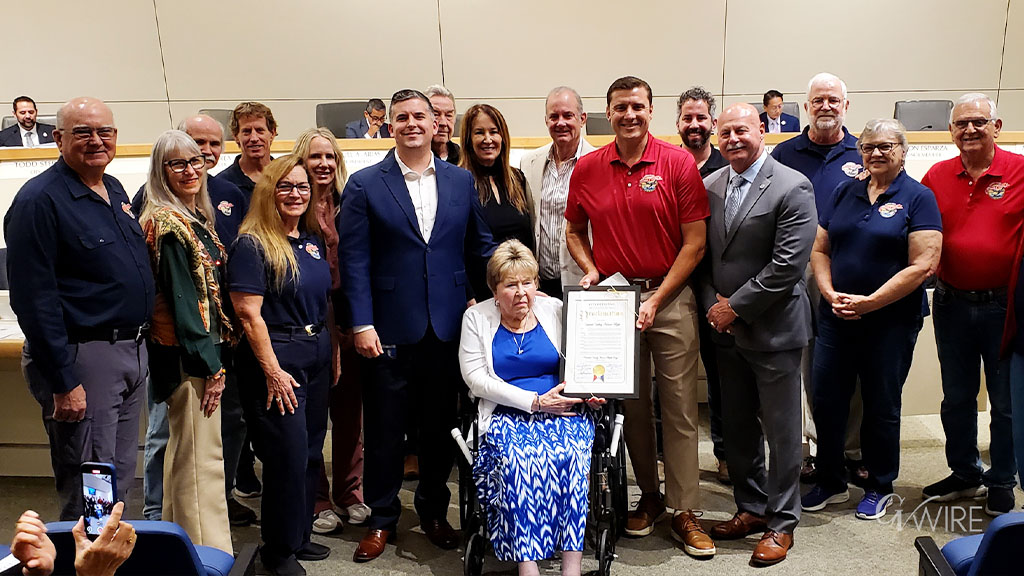The robotrucks are coming, fast. “Like a freaking Corvette — doing zero to 60,” says John Samuelsen, head of the Transport Workers Union of America. (Shutterstock)

- Aurora Innovation, based in Pittsburgh, is the first company to operate a driverless 18-wheeler on an American highway.
- Autonomous trucks, proponents say, could solve a knot of problems facing the American shipping industry
- A survey conducted by AAA this year found that 61% of motorists in the U.S. feared self-driving vehicles.
Share
|
Getting your Trinity Audio player ready...
|
The semitruck rumbled down the congested, five-lane Texas highway, letting a small sedan pass on its right, then accelerating past another semi on its left.
In the back seat of the truck’s sun-drenched cabin, a middle-aged man watched YouTube videos on his phone. Behind him, a 53-foot refrigerated trailer carried nearly 25,000 pounds of pastries.
Nobody was in the driver’s seat.
Last month, Aurora Innovation, based in Pittsburgh, became the first company to operate a driverless 18-wheeler on an American highway, ushering in an era that could dramatically change how cargo moves across the United States.
Autonomous trucks, proponents say, could solve a knot of problems facing the American shipping industry, which has struggled to recruit drivers for grueling, low-paying long-haul shifts, and which expects major growth in cargo shipment activity in the coming decades, driven by the overwhelming popularity of online shopping.
These new trucks won’t need sleep, they won’t speed, and they won’t get road rage. They won’t ride the brakes or make unnecessary lane changes, wasting fuel. And they won’t need to abide by the 11-hour daily driving maximum imposed on long-haul truckers for safety reasons.
“If you’re a farm that has fresh produce, the reach of your farm just expanded dramatically,” said Chris Urmson, the CEO of Aurora, who was riding in the back seat during the first run.
New Truck Logs More Than 1,000 Driverless Miles
Aurora’s new truck, which has already logged more than 1,000 driverless miles shuttling goods along Interstate 45 in Texas, is equipped with nearly 360-degree sensors that can detect objects 1,000 feet away.
But some truckers, academics and labor groups are uneasy. They see an unregulated and risky sphere emerging, and worry that American roads could be facing a new menace.
Byron Bloch, an auto safety expert in Maryland, said that federal oversight of the new robotrucks was “totally inadequate” and that the technology was being rushed into use with “alarming” speed.
“My initial thought is: It’s scary,” said Angela Griffin, a veteran truck driver from outside Hagerstown, Maryland.
She said misting rain had caused AI-powered scanners on her semitruck to malfunction, and she worried that unpredictable traffic patterns in congested areas or challenging weather conditions could lead to catastrophic errors by unmanned trucks.
Griffin recalled a particularly difficult episode: Driving down a rain-soaked Interstate 95 in Fredericksburg, Virginia, early one morning, signs directed her that the right two lanes would be blocked off because of construction.
Following the signage, she moved her semi to the far left lane, but when she went around a bend, she discovered the sign was wrong: two construction trucks were parked in the left lane, she said. There was a semi on her right. Workers were in between the trucks, and there was no left shoulder. She slammed on the brakes and yelled. Her truck pulled up just in time.
“I thought for sure I was going to kill those people,” she said. “I don’t see how a driverless truck would have been able to read and recognize the threat that was imminent.”
And Griffin wondered if the lack of a driver might slow the response time if an autonomous truck runs over a pedestrian, or freezes in the road and gets rear-ended. (Urmson, the Aurora chief, declined to say how many people in a remote assistance center would be assigned to each robotruck.)
AAA Survey Indicates Widespread Concern
Semitrucks, the skeptics note, bring dangers different from those posed by the self-driving cars that have started to take over the streets of San Francisco; Phoenix; Austin, Texas; and Las Vegas. The trucks are far heavier, and need at least a football field’s length to come to a complete stop at highway speeds. Some carry flammable or hazardous materials.
The rollout of robocars has itself been bumpy. In Arizona in 2018, a driverless car ran over a pedestrian walking a bicycle, killing her. In San Francisco and Austin, the vehicles have slowed emergency response times and caused accidents.
With larger vehicles, the critics say, the dangers multiply. The risks seemed to crystallize on an Arizona highway in 2022, when an autonomous truck with a driver aboard veered across Route 10 and careened into a concrete barrier. (Nobody was hurt.)
“It’s potentially disastrous from a safety perspective,” said John Samuelsen, head of the Transport Workers Union of America, who is also worried about trucking jobs being automated out of existence.
Samuelsen appears to have public opinion on his side. A survey conducted by AAA this year found that 61% of motorists in the United States feared self-driving vehicles and that 26% were unsure about them.
Robotrucks Are Coming Fast
Just about everybody agrees on one thing. The robotrucks are coming, fast. “Like a freaking Corvette — doing zero to 60,” Samuelsen said.
The consulting firm McKinsey & Co. has projected that 13% of the heavy-duty trucks on U.S. roads will drive themselves within a decade.
For now, Aurora, whose investors include Uber, has operated just two trucks without a driver — only in good weather and during the day. And last week, Aurora said it was temporarily returning an observer to the driver’s seat at the request of the truck’s manufacturer. But Aurora says it plans to expand its driverless runs to at least 20 trucks by year’s end, and to push into more challenging conditions.
The company is fine-tuning the technology for bad weather, and said its robotruck would drive conservatively in the rain and use blasts of high-pressure air to clean the lenses of its sensors. Runs in the snow appear more distant. (Urmson previously ran Google’s self-driving car project, now known as Waymo, which has had successes in San Francisco and other cities.)
At least three other companies are also developing driverless trucks. One of the companies, Kodiak Robotics, has started to use driverless trucks on dirt roads in Texas.
Experts spoke highly of Aurora, describing the company as a leader in safety. But they also expressed concern about a lack of regulation.
“What Aurora’s doing is being much more careful than most,” said Philip Koopman, an engineering professor at Carnegie Mellon University who specializes in autonomous vehicles. “But there’s still no requirement for independent checks and balances.”
The Transportation Department, which regulates commercial trucking through its Federal Motor Carrier Safety Administration, said in a statement that “comprehensive federal regulations specific to automated trucks are still under development.” But the department added that it was working with the trucking industry and state governments to “modernize safety oversight.”
‘Freedom to Succeed,’ Says Gov. Abbott
Gov. Greg Abbott of Texas, a Republican, said in a statement that he welcomed the arrival of Aurora’s trucks and that his state “offers businesses the freedom to succeed.”
Although there is no federal regulatory framework in place, a number of states have considered legislation to regulate self-driving trucks.
Under normal circumstances, experts said, robotrucks may prove much better at driving than humans. “For our ordinary set of traffic crashes, automated trucking will be safer,” predicted Bryant Walker Smith, a law professor at the University of South Carolina who focuses on driverless vehicles, citing existing research on vehicle automation.
But experts caution that it is impossible to predict how the trucks will react to circumstances their designers did not anticipate: a storm of tumbleweeds, perhaps, or a broad cyberattack that affects their systems.
“This technology is really good at things it’s practiced, and really bad at things it has never seen before,” Koopman said, adding, “From a safety point of view, nobody knows how it’s going to turn out.”
This article originally appeared in The New York Times.
By Tim Balk
c.2025 The New York Times Company



















